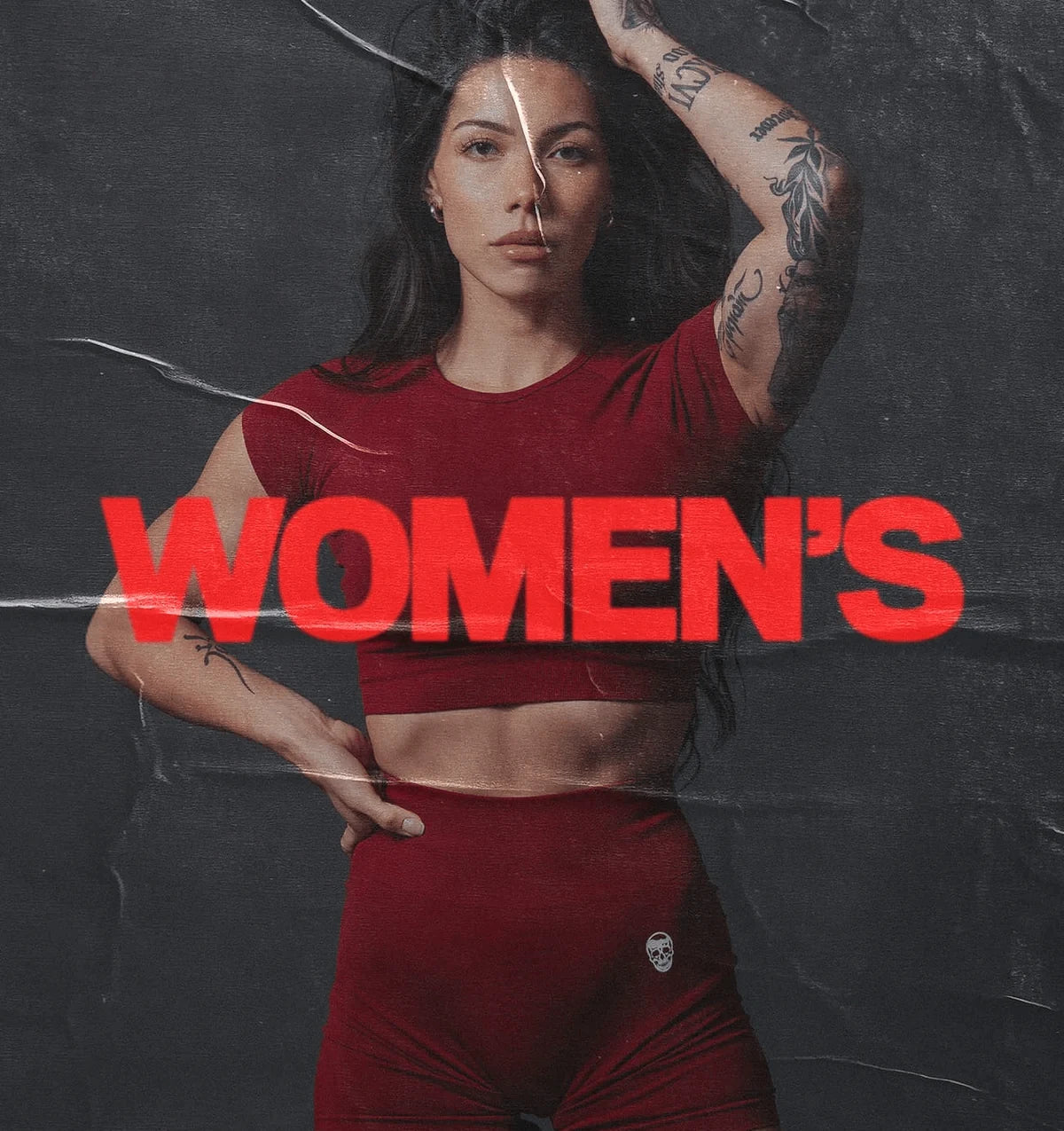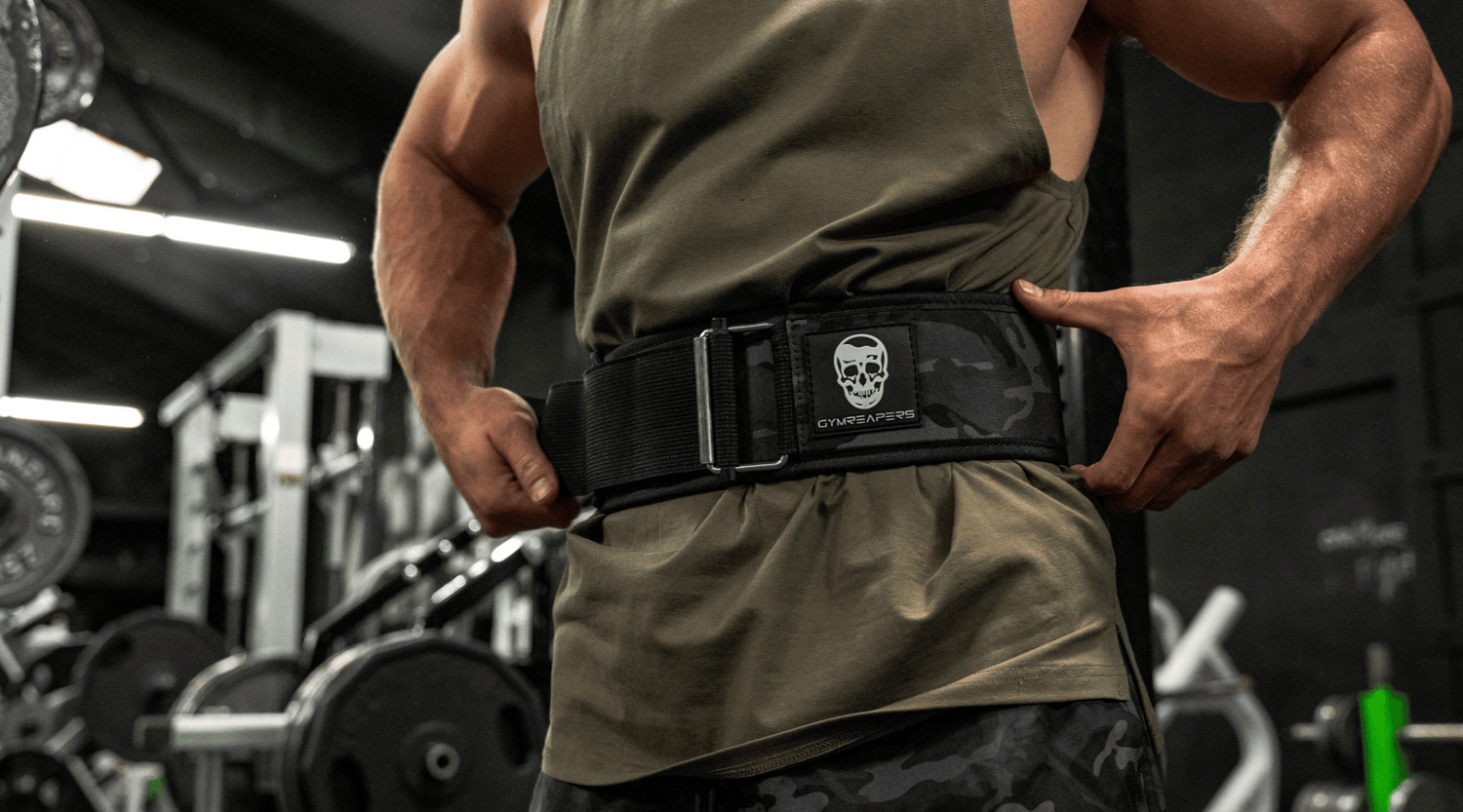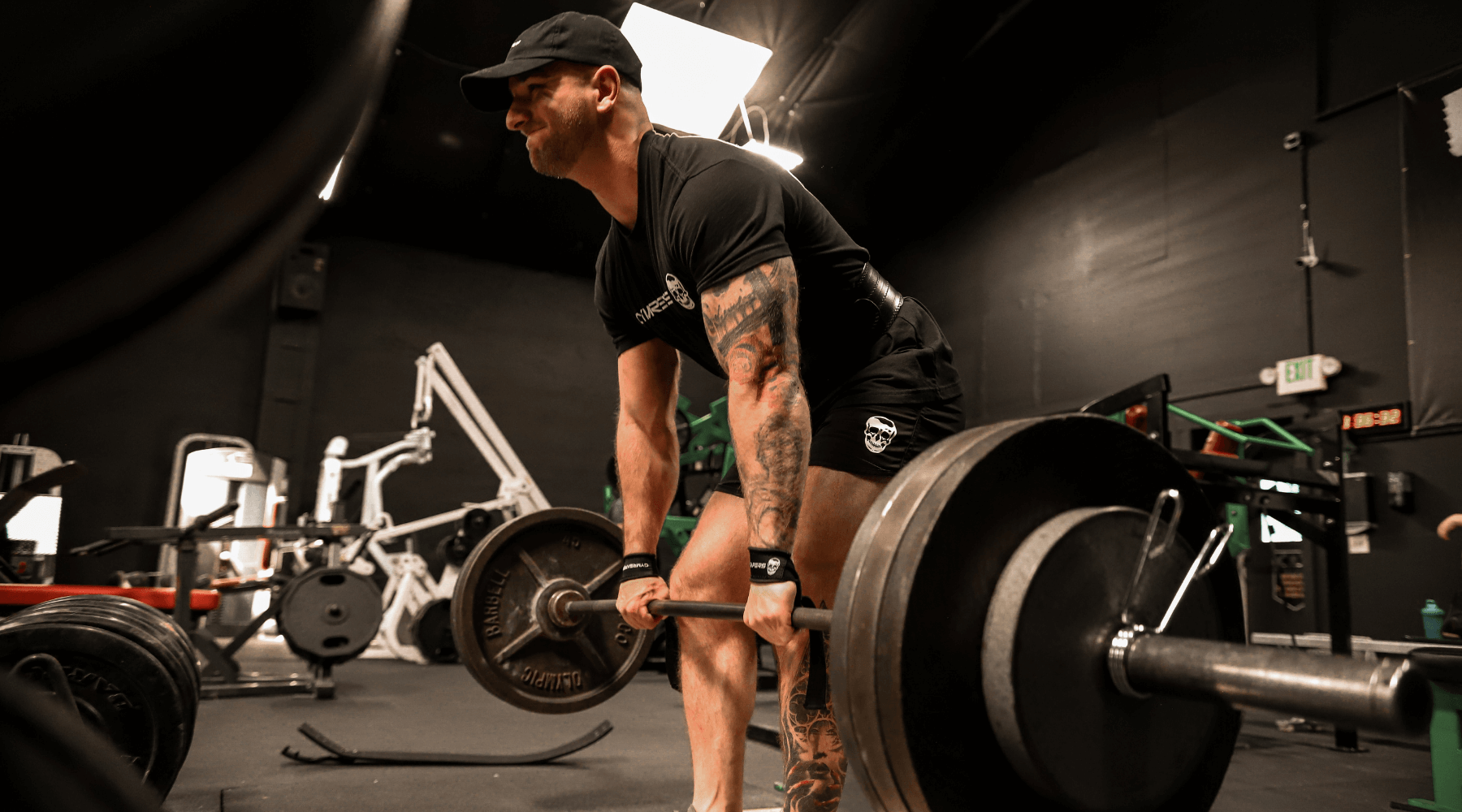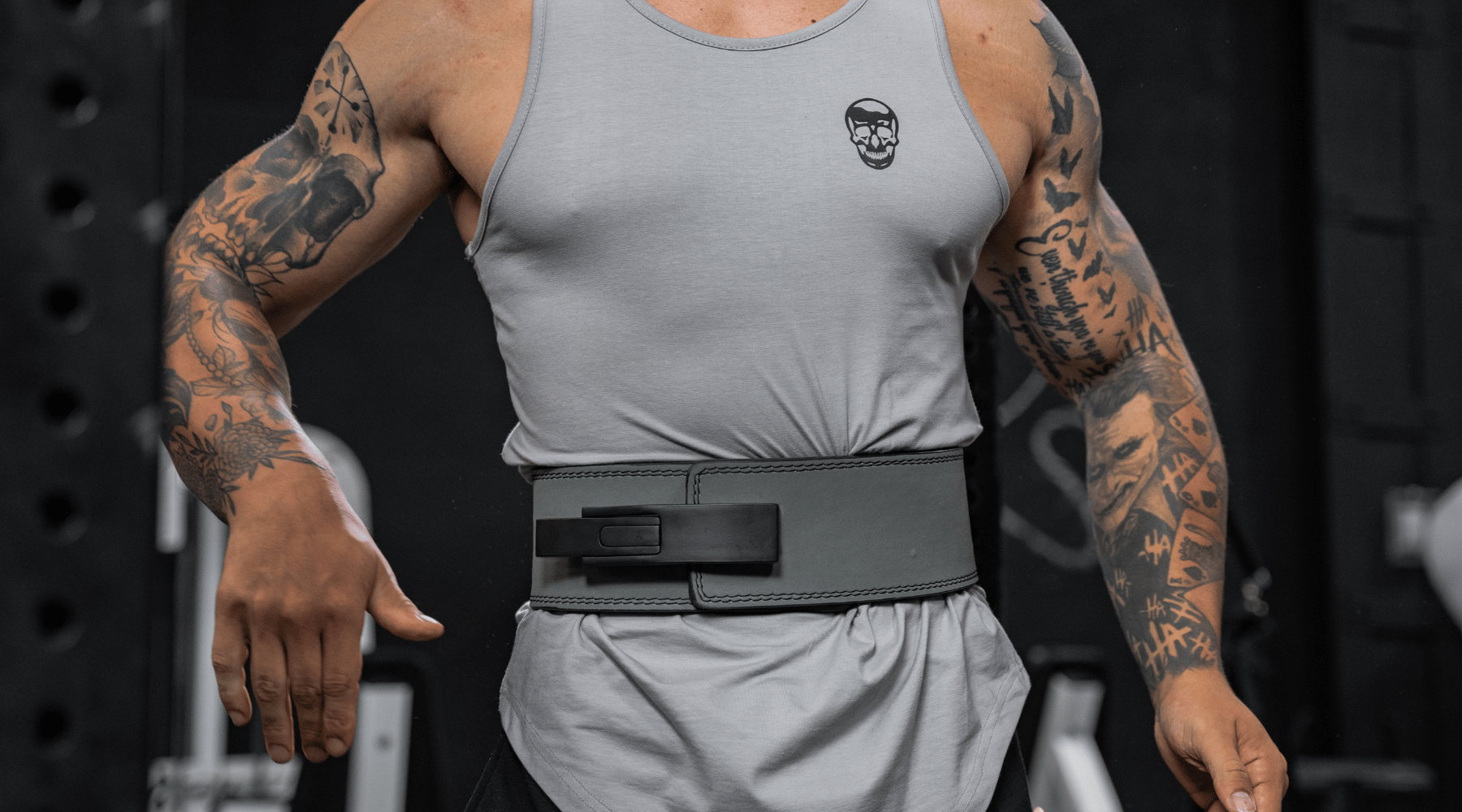Weightlifting belts come in different styles, thicknesses, and materials, and based on what kinds of activities and exercises you do in the gym, one type may be better than others.
If you purchase the wrong type of lifting belt for your training goal or sport needs, then at minimum you'll find it uncomfortable, and at most it will hinder your performance.
Below, I'll cover 7 different types of lifting belts, and explain their pros, cons, and who they're best suited for.
What Defines a Weight Lifting Belt?

A weightlifting belt is a belt used to help provide support during a lift. Lifting belts can vary based on style, size, and material used.
Weightlifting belts are worn around the waist and secured fairly tight. The purpose of the belt is to provide you with a rigid structure to expand your midsection as you lift, which can help provide additional support as you brace your core.
It is important to point out that a lifter should be able to brace properly without a belt before lifting in a belt, as the belt is a supplement to proper bracing and breathing mechanisms.
What Are The Different Sizes of Lifting Belts?
Lifting belts vary in size based on the style of the belt. When looking at belts, you actually will measure both the width and thickness of the belts and match those to your needs.
Width
The width of the lifting belt is the distance between the top and the bottom of the belt when it is on you, and ranges typically between 3-6 inches. Some belts even have a tapered width, which is typically wider in the back, and tapers down to be less wide in the front (see tapered belts below).
- Taller and bigger individuals should opt for wider belts, whereas belts that are not as wide may be a better choice for shorter or smaller lifters.
- If you compete in a strength sport, it is important to note that some sports regulate the width of the belt a lifter can wear, so be sure to check with your federation or governing body for specs.
Related Article: 3-inch Vs. 4-inch Lifting Belt: Which Do You Need?
Thickness
Lifting belt thickness varies based on the material and style of the belt. Usually, belt thickness ranges between 6.5mm (¼ inch) to 13mm (½ inch) belts.
- Some belts are thin and flexible (like 6.5mm belts) and are better for lifting that requires more flexibility and/or when looking for general support. For example, weightlifters, bodybuilders, and general strength training.
- Other belts are thicker and stiffer (10mm-13mm belts), offering greater stability but lacking the ability to allow you to move as freely with them on. These belts are often used during heavy lifting and when rigidity is necessary. For example, beginner and advanced powerlifters.
Taper
Some weightlifting belts offer a tapered design, which entails a wider back of the belt that transitions to a slimmer belt width on the sides and in the front.
- This belt style is good as it can contour better for some lifters, especially those who find themselves performing deep squats or movements where they need the best balance between support and flexibility.
Related Article: Olympic Lifting Belt Vs Powerlifting Belt: What Are the Differences?
What Are The Different Materials For Lifting Belts?

Lifting belts are typically made from leather or nylon. The material used will be important in the selection of your lifting belt, as it can impact the rigidity and overall structure it provides.
Leather Belts
Leather belts tend to be more of a rigid style belt, offering more support and structure when worn.
While this is not to say that all leather belts are not flexible, most lifters who are looking for more support and rigidity will opt for a leather belt (i.e. powerlifters).
Nylon Belts
Nylon belts can offer good support, but they really excel when a lifter needs support and flexibility to move freely while wearing them.
Unlike leather belts, nylon usually allows you to have fewer restrictions when moving in deeper ranges of motion or can be worn throughout a workout and provide support while allowing you to move freely (i.e. Olympic weightlifters or Crossfitters).
What Are The Different Fastening Mechanisms of Lifting Belts?
Depending on the lifting belt that you select, the fastening mechanism will vary based on the intended use. Below are some of the most common fastening mechanical seen on lifting belts.
Prong Belt
The prong lifting belt is the most common style and is also known as a buckle-style belt.
The buckle belt usually consists of 1-2 prongs and offers you a range of holes to get a good fit (just like the belt you use for pants).
Prong belts are easily adjustable, so if you want to have more support during one lift and less support during another lift, you can do that.
Lever Belt
The lever belt is secured by a lever/latch system, where you match the lever notch to a hole in the belt.
This lever system offers you maximum rigidity and support and is generally reserved for more advanced lifters or powerlifters.
Unlike a prong belt, the lever belt does not easily adjust (without the use of a screwdriver). So while you’ll get the most support, you can’t adjust the tightness on a lift-by-lift basis.
Velcro Belt
Velcro belts are secured by looping the end of the belt through a buckle and then using velcro to fasten the belt.
The velcro belt allows you to get a precise fit, as you do not need to match up with a preexisting hole in the belt like the prong or lever style belts.
These can come undone if you are using an older belt, or are building high amounts of pressure under a max load.
Ratchet Belt
Ratchet belts provide dual fastening, through a ratchet-style fastener that then has you velcro the belt. It’s also known as a “quick locking belt”.
Unlike a velcro belt, the ratchet belt provides dual support and security, giving you all the benefits and flexibility of a velcro-style belt with a very secure fit.
What Are The Different Types of Lifting Belts?
Most people buy lifting belts based on the specific nature of their gym activity.
Below we’ll break down 7 different types of lifting belts based on these activities, and discuss their pros, cons, and some of our top picks.
1. Recreational Weight Training Belts

These belts are best for general fitness use and lifters looking for a basic level of support. While these belts can often provide adequate support for most gym lifters, they are often not as rigid or specific for certain sports and movements.
Features
- Typically they are easy to put on, and either fastened with a single prong buckle or velcro.
- Allow for a snug and comfortable fit, and can provide support for most movements.
Pros
- Easy to use, and can be put on and taken off with ease.
- Can be worn for a wide variety of exercises.
Cons
- May not provide enough support for very strong and advanced lifters.
- May not be the best fit for some movements. This is where picking a belt based on your specific needs is best if you are a competitive lifter of needs to wear a belt for specific movements.
Top Pick
- Best Leather Belt for Heavy Lifts - 10mm Single Prong Belt
- Best All-Purpose Belt and Beginner Belt - Quick Locking Weightlifting Belt
2. Bodybuilding Belts

Bodybuilders usually will wear belts to help support them during heavier compound lifts like squats, bent-over rows, and Romanian deadlifts. Bodybuilders typically need rigidity but also may want some flexibility as they may be performing longer duration sets.
Additionally, a belt that can be put on and taken off easily is a must as it allows them to have a vertical belt for a wide array of movements.
Features
- Provides support for heavier compound lifts like squats and deadlifts, yet can also be worn for other movements like bent over rows and overhead presses.
- Provides a snug and secure fit, but is also comfortable enough to wear for longer durations.
Pros
- Helps to provide support during heavier workouts.
- Provides general stability during other movements where you may not need ultimate rigidity yet still want some support.
Cons
- Some belts may be too rigid for some movements and can be uncomfortable if a lifter is deep into a range of motion (for example, a thick leather belt may be uncomfortable when performing bent-over rows or deep front squats).
Top Pick
- Best Leather Belt for Heavy Lifts - 10mm Single Prong Belt
-
Best All-Purpose Belt - Quick Locking Weightlifting Belt
-
Best Tapered Leather Belt - Leather Weightlifting Belt
3. Powerlifting Belts

Powerlifting belts are typically made of leather and use a prong or lever fastening mechanism. These belts are typically 10-13mm in thickness, and 10cm in width.
All Gymreapers belts are the approved belt size for the International Powerlifting Federation (IPF) and USA Powerlifting (USAPL).
Features
- Thicker belt, often made from leather to provide ultimate rigidity and support for heavy squats and deadlifts.
- Uses a prong of lever fastening mechanism to provide a snug and secure fit that will not come undone under heavy loads.
Pros
- Provides the highest levels of stability and rigidity, necessary for very heavy loads.
- Fastening systems will get you the snuggest and best fit to ensure the belt does not loosen or come undone when lifting.
Cons
- While they provide excellent support and rigidity, they can be restrictive at times if you are trying to expand the range of motions.
- They can be tricky at first to learn how to get a proper fit.
Top Pick
- For Everyday Powerlifting Use - 10mm Single Prong Belt
- For Competitive Powerlifters - 10mm Lever Belt
-
For Serious and Advanced Powerlifters - 13mm Level Belt
4. Olympic Weightlifting Belts

Olympic weightlifting belts are either made of leather or nylon. Leather belts offer rigidity, however, some lifters may opt for a nylon belt as it offers a little more flexibility when getting into deep cleans and snatches.
These belts often have a slight taper, which will have the back of the belt slightly wider than the front of the belt, which will help the lifter have less restriction as they sit into a squat. The width of the belt at its widest point should meet competition standards set forth by governing bodies such as USA Weightlifting (USAW) and the Internal Weightlifting Federation (IWF).
Features
- Typically these offer greater flexibility necessary to assume deep squats, snatches, and cleans. These belts may have a taper to them as well to aid in this.
- Fastener mechanism is typically a smaller prong-style buckle, or a ratchet and velcro fastening system to stay out of the way as you keep the barbell close to the body in the snatch and clean.
Pros
- Adjustable fastener that allows you to get a snug fit, with enhanced security by using both velcro and a ratchet fastener (rachet style, like the GymReaper Quick Locking Belt).
- Flexible yet rigid, which may be ideal for lifters who struggle to find a comfortable belt that support them and still allows them to move freely.
- Minimal front fastener design that does not get in the way when performing cleans and snatches.
Cons
- Requires a lifter to understand how to breathe and brace properly, as nylon is less rigid than leather (can still be very supportive).
- Leather belts, unless tapered, may be uncomfortable when in deep squats, snatches, and cleans.
Top Pick
- Best Nylon Belt - Quick Locking Weightlifting Belt
-
Best Tapered Leather Belt - 7mm Tapered Weightlifting Belt
5. Crossfit Belts

This style of the belt can vary based on the needs of the lifter, but typically a lifter will opt for a belt that offers both flexibility, comfort, and rigidity.
Additionally, crossfitters will seek out a belt that can be put on and taken off daily quickly as it allows for faster transitions between belted and no belted movements.
Features
- Usually made of nylon to allow for more flexibility and movement.
- Fastening mechanism is typically a velcro or ratchet system, which allows the lifter to customize the fit quickly based on the movement needs (the lifter may loosen the belt on rowing to allow more breathing, and tighten it on squat cleans).
Pros
- Flexible material allows the lifter to keep the belt on for a wide range of movements and ranges of motion.
- Velcro and/or ratchet fastener mechanism allows the lifter to quickly secure belt tightly, or to wear it looser in between heavier movements.
Cons
- May not provide extreme levels or rigidity for maximal lifts like deadlifts and squats.
- Velcro can come undone during some workouts, especially if the belt is not quality or is an older style. This is why we recommend a dual velcro and ratchet-style belt.
Top Pick
-
Best Overall CrossFit Belt - Quick Locking Weightlifting Belt
6. Dip & Pull-Up Belts

These belts are made for adding external weights to the dip and pull-up. To use these belts, you secure a weight plate (can also use kettlebells) to the belt by running a chain through it (which is attached to the belt).
Features
- Belt is tapered to have wider, more padded back area to contour to the body and provide comfort while having weights on the belt.
- Heavy duty steel chain allows you to add hundreds of pounds to the weight belt, offering you a great way to progress your pull-ups, dips, and even belt squat.
Pros
- Perfect for progressing all bodyweight movements like pull-ups and dips.
- Padded belt offers comfort, yet still offers a form-fitting design to keep the belt snug and in place, even with added weight.
- Long chain allows you to add plenty of weight and keep them out of the way.
Cons
- This is a highly specialized belt that you can only use for chin ups and dips.
- This belt does not add support to your back or torso.
Top Pick
- Best Dip & Pull-Up Belt - Dip Belt
7. Women's Belts

Belt needs for men and women are no different, other than general body size and height.
Most women will be able to choose from the belts above and match their individual lifting and sport needs, and choose a belt that way. Belts come in a variety of sizes, and most women will be able to find a belt from above that fits their needs.
In some instances, women who have shorter torsos and smaller frames or some of the very light weight classes (i.e. women lifters who have a small area between the top of their hips and the ribs) may benefit from using a 3-inch belt if a straight edge of tapered 4-inch belt is still too big.
Features
- The main feature of this belt is that it is 3-inches, which may be necessary for women who have a short torso (space between their hips and their rib cage)
Pros
- Due to the 3-inch style belt, the belt will not rub into the sides of the body lifters who have a small space between their hips and ribs..
Cons
- This belt can be very difficult to find for sale.
- This belt is 3-inches, which provides some support, however it may lack the needs of your actual sport or lifting style.
Top Tips For Picking The Right Lifting Belt
When choosing a lifting belt, it is important to know the rules of your lifting organization.
If you are a powerlifter, the International Powerlifting Federation (IPF) and USA Powerlifting (USAPL) approve lifting belts that are up to 10cm wide, and 13mm thick.
If you are an Olympic weightlifting, you will want a belt that is no more than 4 inches wide (10cm), as the International Weightlifting Federation (IWF) allows belts up to that width to be used in competition.
Choose the Right Material Based on Your Lifting Style
Nylon belts provide you with both support and flexibility, and are generally a less expensive belt. Nylon belts are great for beginners, however, they are also great belts for many high-level weightlifters as they allow for ultimate freedom of movement in deep snatches and cleans.
Leather belts can also be used when flexibility is a concern and is typically achieved by a tapered leather belt.
Non-tapered leather belts are common with lifters who want more rigidity and are not overly concerned with needing a lot of comfort or flexibility to assume deep ranges of motion (such as in the snatch, clean, or full below parallel depth squats).
Find the Balance Between Price and Quality
When looking for a belt that matches your lifting needs and your budget, you want to first determine if you need a leather belt of a nylon belt.
If you are someone who will be using a belt primarily for heavy squats and deadlifts, then you may want to go with a 10mm leather belt. You can choose a prong or lever style based on the specs covered above.
If you want a leather belt that allows you to also perform fuller ranges of motion movements, then take a look at the 10mm leather weightlifting belt as it is tapered and may be better for deep squats, bent over rows, cleans, and snatches.
Most competitive weightlifters can typically choose between a nylon ratchet or leather tapered belt, as both provide support and flexibility.
If you are an advanced powerlifter, and need a belt specially for the competition lifts, then you may want to look into a thicker 13mm leather belt.
For all other lifters, you may want to opt for a nylon belt, as it provides you support yet is less expensive than leather-style belts. Even more advanced lifters looking for support on a budget can find that in nylon rachet style belts.













1 comment
Matt A Chapman
Does the lever belt that you screw in, not leave any holes I’m shirts damaging them? It seems belt buckle style leaves all those tiny holes in the shirt.
Leave a comment
All comments are moderated before being published.
This site is protected by hCaptcha and the hCaptcha Privacy Policy and Terms of Service apply.